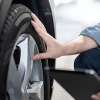
Winter can bring with it some difficult driving conditions, so now is a good time to remind your drivers how to drive safely when the temperature drops below zero. When we expect freezing conditions we normally get a weather warning from the Met office, however you and your drivers shouldn’t rely on these and should always take extra care when travelling in winter.
- Stopping distances double in wet weather and it can take ten times longer to stop in snowy or icy conditions. Drivers should approach junctions expecting to stop well before the STOP or GIVE WAY line and every steering, acceleration or braking input should be as smooth and gentle as possible.
- Salt will often make windscreens, headlights, number plates and rear parts of vehicles very dirty. Advise your drivers to stop at service stations if travelling long distances and to clean their windscreen and headlights with a clean cloth.
- Ensure screen wash is topped up or checked regularly as it can be used more throughout the winter to clear grit and other winter dirt.
- Action any warning lights on vehicles as soon as possible. Being stuck on the side of the road is never good but breaking down in freezing conditions is a high-risk situation.
- A winter driving kit includes an ice scraper, de-icer, blanket, torch, shovel, something to eat and a fully charged mobile phone. These are essential items for anyone who breaks down in winter so advise your drivers to carry them if possible.
- Avoid overtaking a gritting lorry as the road ahead is likely to be untreated and could be icy.
- It’s important to keep vehicles clean throughout the winter as the salt in grit can cause corrosion to any exposed parts. Ensure that vehicles are thoroughly washed to stop salt from settling.
- Just because the winter sun is out does not mean the roads might not be icy. Micro climates of icy patches will linger in areas such as bridges and exposed sections, where the sun has not yet reached.
- Keep the tread on your tyres above 2mm (ideally 3mm), the more tread you have the more water they can cope with. Letting your tyres get down to the legal limit of 1.6mm is not recommended, and don’t forget you can always consider winter tyres if you are in an area where they will benefit you.
Contact your IAM RoadSmart account manager for free winter driving tips posters, or for any updates to your driver policy. If you’re not yet a customer contact us today to see how our innovative fleet risk management solutions can help you to create a safer, more efficient fleet no matter what the weather.
IAM RoadSmart’s head of driving and riding standards, Richard Gladman said: “Preparation is the key to avoiding a dangerous situation whilst driving in snowy or icy conditions. Don’t rely on the performance of your car systems to get you out of trouble – allow time, make sure you have good visibility all round and carry the right equipment. If conditions are extreme remember the best advice is not to travel.”



